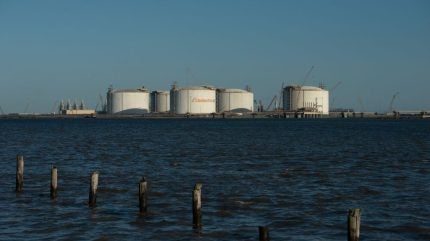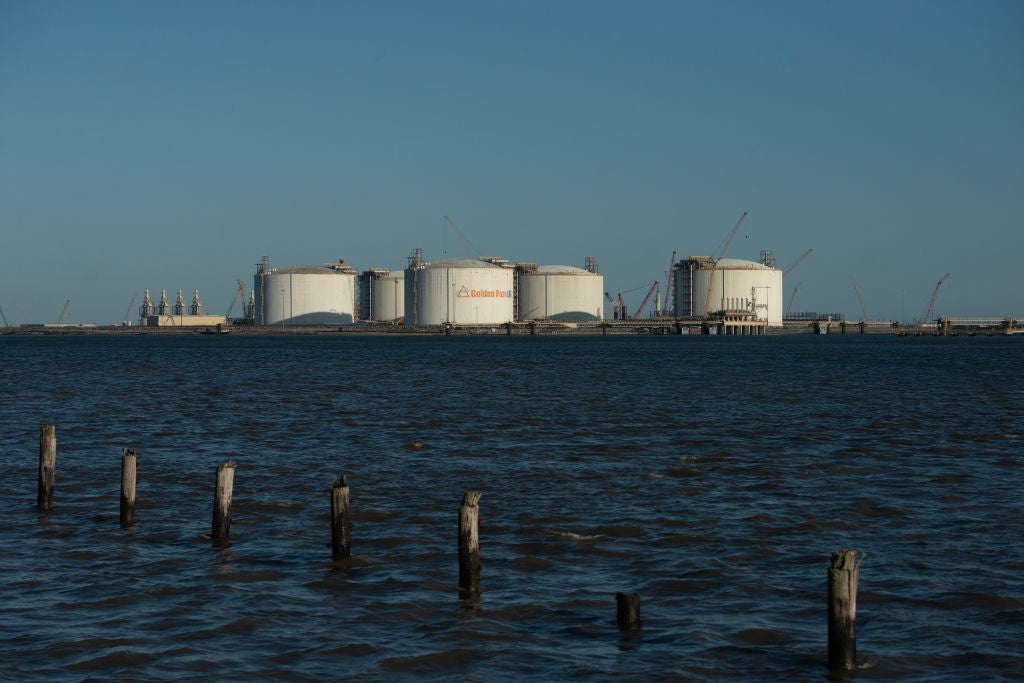
Last week’s explosion at the Freeport LNG export plant in Texas has thrown into stark relief the trade-offs inherent in the US’s pursuit of maximising liquefied natural gas (LNG) exports. The blast on 8 June 2022 cut the country’s LNG exports by approximately two billion cubic feet per day (Bcf/d), or 20%. The plant will remain offline for at least three months, with full operations not expected until late 2022. Considering the parlous state of global supply chains, the outage could be much longer if spare parts are required.
Market reaction was as dramatic as the explosion itself. The month-ahead price of gas on Henry Hub crashed from a peak of $9.57 per million British thermal units (MMBtu) to $8.15/MMBtu within just a few hours. Why? Freeport’s outage made 2Bcf/d of US shale gas unexpectedly available to the domestic gas market, which is running hot due to record demand for feed gas from the seven LNG plants now in operation across Texas, Louisiana and Georgia.

A similar reaction occurred in the Texas electricity market. The average price of power across all ERCOT locational nodes and hourly segments briefly fell from more than $60 per megawatt-hour (MWh) to around $26/MWh when the explosion took Freeport offline. That’s because Freeport is the only LNG plant in the US to use grid-powered electric motors to compress and chill natural gas. The incident shut down the plant’s three 75MW-rated GE motors.
In Europe, the market reaction was the precise opposite. Freeport is a critical piece of infrastructure supplying an estimated four LNG cargoes per week to gas-starved European markets. The outage prompted month-ahead gas on the European benchmark TTF to spike 12.6% to €88.70/MWh in that morning’s trade. UK day-ahead prices jumped in tandem by 22% as traders priced in the missing volumes.
Freeport LNG said in a statement on 14 June, six days after the explosion, that overpressure and rupture of a segment of an LNG transfer line led to the “rapid flashing of LNG and the release and ignition of the natural gas vapor cloud”. An investigation is under way to determine “the underlying precipitating events that enabled the overpressure conditions in the LNG piping”, it added.
This announcement also confirmed the facility will be offline for much longer than the original time frame of three weeks, prompting more market turmoil. Henry Hub crashed a further 15% on the news, while TTF gained 14% – egged on by the news that Gazprom cut flows of Russian gas on the Nord Stream 1 pipeline.
How well do you really know your competitors?
Access the most comprehensive Company Profiles on the market, powered by GlobalData. Save hours of research. Gain competitive edge.

Thank you!
Your download email will arrive shortly
Not ready to buy yet? Download a free sample
We are confident about the unique quality of our Company Profiles. However, we want you to make the most beneficial decision for your business, so we offer a free sample that you can download by submitting the below form
By GlobalDataGood timing, bad timing
These price movements come at an auspicious time for US energy consumers, and an inauspicious one for Europeans.
Any reduction in electricity demand will be welcomed in Texas, where a heatwave is pushing power consumption to record highs as homes and offices power up air conditioning units. The combination of surging power demand and soaring natural gas prices has prompted a 70% uptick in consumer bills so far this year, with further increases expected over the summer.
US wholesale energy prices have been on a strong upward trend in recent months, partly because US gas inventories are running well below the pre-pandemic five-year seasonal average. This year has 3wseen a blistering acceleration in US LNG exports to Europe, which is aggressively buying spot cargoes in a bid to reduce its reliance on Russian gas.
Analysts are now warning of a ferocious summer LNG price war as Asian buyers compete with Europe for increasingly scarce spot cargoes ahead of the winter heating season. Poorer gas-importing countries are already being priced out; Pakistan is facing a balance-of-payments crisis and enduring blackouts after Italy’s Eni and trading house Gunvor cancelled long-term LNG supply agreements to resell those cargoes into red-hot European gas hubs.
Tricky trade-offs
The Freeport outage illustrates how US LNG exports help to keep a lid on soaring European energy prices, while driving up domestic prices. Put simply, more US gas in Europe means less gas in America. So far, the US has enjoyed the economic benefits of its cheap shale gas bounty on the road to becoming a world player on the global LNG stage. Soon, it will have to choose between the two.
Industrial Energy Consumers of America, a Washington-based trade body that has been campaigning for years to cap US gas exports, has seized on this moment to drive home its message: US LNG is hurting American industry.
Paul Cicio, president and CEO of IECA, said: “The significant price drop of over $2.00/MMBtu (on Henry Hub since the Freeport explosion) would save consumers approximately $63bn annually as compared to the average price in 2021. It should be alarming to federal policymakers that the Freeport LNG terminal only exports 2Bcf/d, yet it is having such a significant impact to prices.”
No demand relief in sight
To stop LNG exports becoming a zero-sum game for the US, domestic gas demand must fall and/or US shale production must rise, at the same pace that gas liquefaction grows. A combination of the two (less demand and more supply) would also strike the balance needed to restore US gas inventories to seasonal norms and keep prices stable – but neither seem likely.
The US Energy Information Administration (EIA) forecasts long-term US gas demand rising every year in nearly all use cases out to 2050. Consumption in the commercial, industrial and power generation sectors increases by an average of 0.2%, 0.8% and 0.2%, respectively, every year between 2021 and 2050, according to the reference case in the EIA’s Annual Energy Outlook 2022.
The only exception is the residential segment, where consumption falls 0.1% per year over the same time frame. The net effect is a 0.4% annual increase in overall domestic gas consumption, from 27.39 trillion cubic feet (Tcf) in 2021 to 30.47Tcf in 2050. That increase will happen against a 1.7% annual uptick LNG exports, from 3.58Tcf in 2021 to 5.86Tcf by 2050.
Shale peak looms
So, if US gas demand won’t fall to match rising exports, can production keep pace? Shale gas output grew spectacularly in the 2010s. A net increase in supply of 20Bcf/d since 2016 far outstripped the 10Bcf/d of new LNG export demand, creating the structural surplus that kept Henry Hub at a structural discount to prices in global gas markets – underpinning the original economic case for LNG exports.
However, field declines, constraints on investment and broken supply chains mean the US gas industry is at an inflection point. The Permian, Marcellus and Haynesville shale plays that drive supply growth are rapidly approaching peak production, tipping the US gas market from structural surplus to structural deficit.
That is according to New York investment house Goehring & Rozencwajg Associates, which said in a May 2022 briefing: “The idea that gas supply could falter and as a result that US gas prices could nearly instantly rise four-fold is completely off any investors’ radar. And yet, this is exactly what our models are telling us could happen within the next six months.”
No more cheap US gas?
What would $30/MMBtu on Henry Hub mean for the US energy transition? For starters, LNG exports would falter if feed gas costs rose to the point that liquefying and transporting the molecules to Europe becomes unprofitable. For that to happen, natural gas would first be rendered uneconomic in many domestic end-use segments, making alternatives more attractive – but it would also aggravate inflationary tail risks for clean energy investments.
More homeowners would be convinced to invest in solar thermal or heat pumps for space heating in cooler northern states. Solar PV would become a vital source of onsite generation for homes, apartment blocks and offices to offset spiralling energy bills during the summer cooling season, particularly in warmer climes.
[Keep up with Energy Monitor: Subscribe to our weekly newsletter]
Coal-to-gas switching in the power sector would become a thing of the past, marginalising gas and pushing clean generation up the merit order. This would make coal-to-clean more economically viable, but coal generation would benefit from expensive gas too. The extent to which coal and renewables take market share from gas would depend on the prevailing generation mix in each of the US's regional electricity markets, as well as carbon pricing and other regulations encouraging clean energy uptake.
There would be many negative economic impacts. Energy-intensive US industries such as steel mills would become less competitive in export markets, while the rising cost of steel would worsen the input cost inflation biting at clean energy and storage investments. Electricity would become much more expensive, eroding the case for buying an electric vehicle and hurting the wider electrification push. Data centres, server rigs and bitcoin mining would all face higher running costs, as would manufacturing and assembly lines. Food prices would also rise because natural gas is a primary feedstock for making fertiliser.
The political fallout
The inflationary impacts of expensive gas would ripple through the US economy, exacerbating the depth and duration of the recession that many economists fear is on the horizon. This week’s inversion of US Treasury bond yields presages more Federal Reserve interest rate rises, which will increase the cost of capital – a key determinant of the levelised cost of energy from wind and solar farms and other capital-intensive clean energy investments.
The price of natural gas is by no means the single or most important factor determining these economic trends, but it is a contributory factor. The scope for economic pain arising from expensive gas and electricity will not be lost on policymakers in Washington. The US LNG industry is a key enabler of Washington’s overseas diplomatic agenda – helping war-shocked Europe dial down Russian gas imports and narrowing the trade deficit with China. If pursuing these objectives puts the industry’s social licence at risk, the Biden administration will face the unenviable task of explaining to voters why they must sacrifice their standard of living.
The question of whether to ‘ban fracking’ became a divisive issue in the 2020 Democratic Party presidential primaries. Such a measure would be unconscionable today. Now that the US is no longer insulated from global energy crises, both Republicans and Democrats could find themselves agonising over whether to campaign on a platform to cap or ban LNG exports in the 2024 presidential ballot. If the market deteriorates rapidly over the summer, this issue could rise up the political agenda in time for the 2022 mid-terms.



